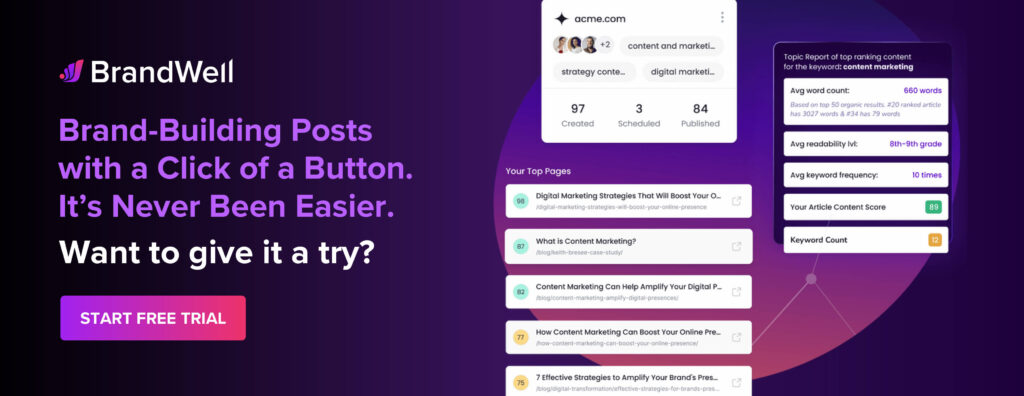Discover top guides, trends, tips and expertise from AIO Writers
7 Competitive Advantage Examples for Business Success
Julia McCoy
Tuesday, 20th Feb 2024
Imagine stepping into a ring where everyone’s fighting to be number one. That’s the business world for you, and having a competitive advantage is like knowing a secret move that puts you ahead of the others. But what are your competitive advantages?
We’re about to explore the different types of competitive advantage in business and how companies shine by reducing expenses smartly and offering distinctive value that makes them the preferable choice of consumers.
We’re talking real-world competitive advantage examples where companies have turned the tables in their favor using these strategies.
Additionally, we’ll delve into the significance of embracing innovation and adjusting to worldwide shifts, vital for maintaining a competitive advantage.
So buckle up; it’s time to learn how to stay ahead in the game.
Table Of Contents:
- What is a Competitive Advantage?
- Types of Competitive Advantage
- Real-World Competitive Advantage Examples
- FAQs – Competitive Advantage Examples
- Conclusion
What is a Competitive Advantage?
Competitive advantage refers to unique attributes or capabilities that allow a business to outshine its competitors, attract more customers, and achieve higher profitability. These advantages are essential for businesses aiming to establish themselves as leaders in their respective markets.
A company’s competitive edge might stem from various sources such as innovative technology, exceptional customer service, or even a strategic geographic location.

Competitive advantage definition from Investopedia
Types of Competitive Advantage
Michael Porter, a world-renowned authority on business competitiveness, identified three fundamental strategies that companies can adopt to secure enduring advantages. These strategies are cost leadership, differentiation, and focus.
Cost leadership is all about making and selling stuff that’s cheaper than the other guys.
Differentiation is about creating products that truly stand out from the crowd.
Focus is where you hone in on specific market segments and offer them something unique and tailored to their needs.
Let’s break down these three competitive advantage examples.
Cost Leadership
In cost leadership, it’s all about becoming the lowest-cost producer in your industry. Think Walmart or IKEA. These industry giants excel in trimming expenses from every angle, while still maintaining a decent level of quality. They buy in bulk, optimize operations, and pass these savings to their customers.
Even smaller enterprises can engage in this approach by focusing on efficiency and expanding their operations as opportunities arise. The key? Streamlining processes and negotiating better deals with suppliers to lower production costs.
Product Differentiation
Differentiation is when you make your product or service stand out because it has something unique. Apple, with its pioneering gadgets and a brand that epitomizes sophistication and cutting-edge technology, truly excels in carving out a distinctive niche.
There are three types of product differentiation: vertical, horizontal, and mixed.
Vertical differentiation is all about clear-cut advantages like price or quality that set a product apart.
Horizontal differentiation, on the other hand, zooms in on consumer tastes like packaging, flavor, or color.
Mixed differentiation blends both approaches — highlighting a mix of objective and subjective product characteristics.
To nail differentiation, think deeply about what makes your offering special — be it design, features, customer service, or technology — and then shout it from the rooftops (or market it wisely online).
Remember: Different doesn’t always mean better for everyone but it means better for your target audience.
Focus
A focus strategy involves targeting a specific niche market rather than trying to appeal to the masses. This could mean specializing in gluten-free baked goods if you’re a bakery or eco-friendly apparel if you’re into fashion retailing.
The beauty of focus strategies lies in understanding and serving your chosen segment so well that competitors simply can’t keep up because they’re spread too thin catering to broader markets.
Warby Parker, by really honing in on the specific desires and necessities of its target audience, has managed to secure a substantial niche despite aggressive rivalry from bigger eyewear corporations.
Gaining an edge over competitors requires not just following one path but often blending these strategies smartly based on changing market dynamics.
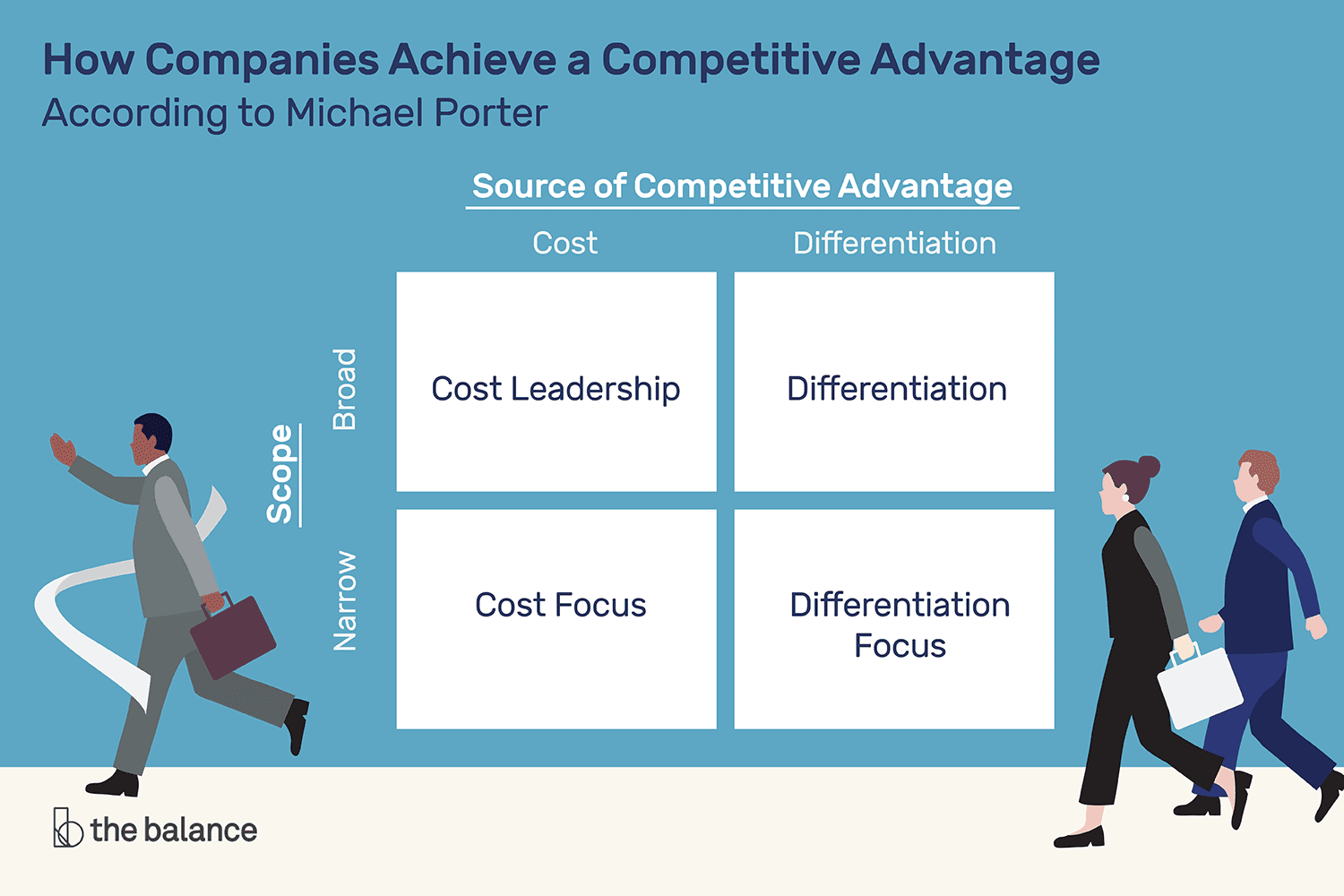
Source: The Balance
Cost leadership, product differentiation, and focus are generic competitive advantages. Porter has also identified three specific types of competitive advantage: strong brand, technological superiority, and access to capital.
Strong Brand
For any company, establishing a robust brand is essential. It not only boosts the effectiveness of advertising but also fosters a deeper emotional bond with consumers.
A powerful brand transcends mere logos and names; it’s a community built on ideas, values, and beliefs, evoking inspiration and uniqueness. It’s the go-to choice for consumers, meeting their expectations effortlessly and staying attuned to evolving social and consumer trends.
To build a strong brand, you first need a clear purpose beyond profit-making. This purpose defines why your business exists. Then, you analyze competitors, identify your target audience, and formulate a strategy.
Crafting a compelling brand story follows — communicate your values, vision, and mission.
Next, shape or refine your brand identity with a strong name, recognizable logo, and unique tone of voice.
Consistency is key here — your messaging, storytelling, and promotional efforts should consistently align with your brand’s purpose.
Technological Superiority
New technology is a fantastic opportunity to revamp business models and streamline operations for better efficiency.
When technological prowess delivers specific perks like automation or data-driven innovations, it becomes a powerful competitive advantage.
Investing in research and development to unveil new products can also capture consumers’ attention and propel a company to the forefront of the digital landscape, setting it apart from rivals.
There’s a myriad of ways to leverage technology for that competitive edge. For instance, using data to understand both customers and employees better can inform strategic decisions. Cloud services enable the storage of vast amounts of data, while artificial intelligence helps with thorough analysis, leading to enhanced efficiency, cost savings, and superior customer experiences.
Apps serve as vital conduits for seamless interactions between a company and its clientele across various platforms.
Cognitive technologies like machine learning and speech recognition streamline processes that once relied on human input.
Furthermore, cybersecurity is crucial in today’s tech-driven world, safeguarding against cyber threats and ensuring the protection of sensitive customer data.
Access to Capital
Large companies across various industries, including manufacturing, space exploration, and healthcare, frequently leverage this form of competitive advantage.
Access to capital denotes the availability of funds, equipment, and materials necessary for the production and distribution of goods. It encompasses resources for storage, refunds for defective products, and funding for marketing endeavors.
Small businesses often grapple with challenges in securing capital to launch products or expand sales. Conversely, large enterprises benefit from ample financial resources for advertising, research and development, and infrastructure — positioning them to outpace competitors.
With access to capital, market leaders can effortlessly raise funds and reinvest additional resources to scale production or venture into new markets.
Now, let’s look at real-world competitive advantage examples and explore how renowned companies have pushed their brands to the forefront of their respective industries.
Real-World Competitive Advantage Examples
Discover how industry giants like Amazon, Apple, Walmart, Tesla, Starbucks, Nike, and Netflix have used their competitive advantage to leave market competitors in the dust.
Walmart
Walmart has become synonymous with savings, but it’s not just about low prices for customers. They achieve this through a relentless focus on efficiency — from logistics to negotiations with suppliers. By prioritizing efficiency, they manage to offer lower prices than their rivals while still keeping their profit margins healthy.
Another factor that turned into Walmart’s competitive edge is its strategic placement of stores in remote areas. By catering to small towns with limited retail options, Walmart effectively monopolized these markets, making it challenging for competitors to establish a foothold. This presence in hard-to-reach locations, coupled with competitive pricing and quality service, solidified Walmart’s dominance in numerous underserved communities.
Walmart’s use of technology for inventory management is especially noteworthy — it uses automation to gain a competitive advantage in the retail space. Automation plays a crucial role in streamlining operations throughout the company’s distribution centers and stores. From product transportation and sorting to packaging and checkout processes, Walmart employs automation technologies to enhance efficiency and customer satisfaction.
Scan-and-go kiosks in stores reduce wait times, while automation in distribution centers, powered by robotics and artificial intelligence, optimizes supply chain processes, ensuring accuracy and speed. Thanks to AI, Walmart shelves are stocked efficiently while avoiding overordering — saving millions annually.
In essence, Walmart’s strategy turns cost-saving into its most potent weapon against competition.

Apple
If there’s one company that knows how to stand out, it’s Apple. Their approach? Deliver products so unique that they set the standard for what consumers expect in quality and design.
This isn’t just about having sleek gadgets; Apple backs up its designs with robust ecosystems like iOS and exclusive services such as iTunes and the App Store which lock users into their world seamlessly.
No doubt, Apple’s biggest competitive edge is its strong brand reputation — built over many years of delivering high-quality products with clean, intuitive designs. This brand equity not only distinguishes Apple in the global market but also fosters strong customer loyalty. With consistent brand recognition and a seamless ecosystem of interconnected devices and services, customers often opt for additional Apple products, reinforcing the company’s market dominance.
Technological innovation is the core of Apple’s success, as the company continually pushes boundaries with groundbreaking products like the iPod, MacBook, and iPhone. Through substantial investments in research and development, Apple maintains its position at the forefront of technological advancement, consistently introducing cutting-edge features and functionalities to captivate consumers. In 2022 alone, Apple allocated over $25 billion to R&D, showcasing its unwavering commitment to innovation.
Apple continually reshapes the market landscape, not merely by keeping pace but by establishing new benchmarks in innovation and user experience.
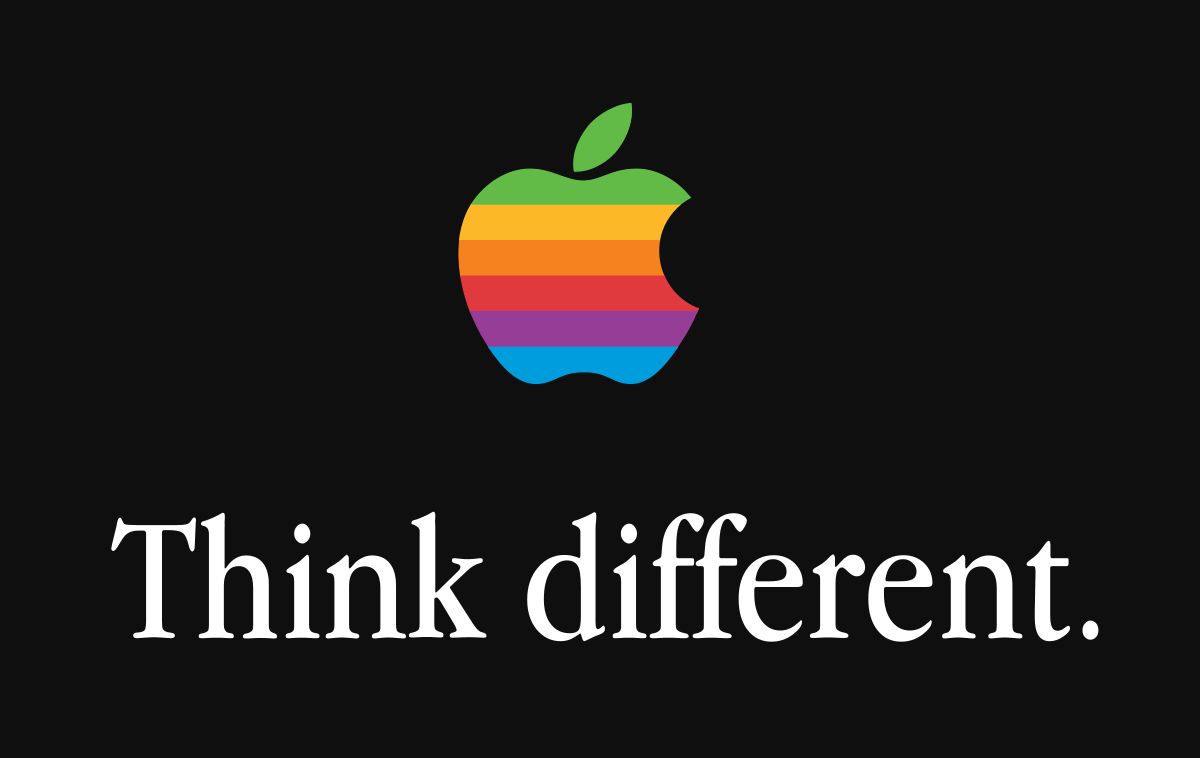
Amazon
Amazon’s success stems from a multifaceted approach to competitive advantage.
First, the company prioritizes cost leadership — focusing on customer satisfaction over immediate profits.
Recognizing the significance of delivery costs, Amazon pioneered free shipping for purchases exceeding $25, a move that significantly enhanced customer appeal and boosted sales. This strategy was further amplified with the introduction of Amazon Prime, providing expedited two-day delivery for time-sensitive customers.
Amazon also employs product differentiation to stand out in the market. Offering an unparalleled selection of goods, the company serves both buyers and sellers through its expansive marketplace. This broad product assortment caters to diverse consumer needs, ranging from everyday essentials to specialized items, aligning with Amazon’s customer-centric ethos and enhancing service convenience.
Amazon maintains a focus on technological superiority to elevate customer service standards. The platform’s user-friendly interface, coupled with features like enhanced search functionality, personalized suggestions, and one-click ordering, prioritizes ease of use for customers.
Lastly, Amazon extends its technological prowess through its subsidiary AWS, offering cloud computing services to individuals, businesses, and governments to diversify its revenue streams and cement its position as a leader in the tech industry.

Nike
Nike’s success in the sports apparel and footwear industry is attributed to its product differentiation and efficient brand management.
Nike boasts unparalleled brand awareness, driven by its iconic swish logo and slogan “Just Do It” which has solidified its status as a household name. Endorsements from high-profile athletes like Michael Jordan and Tiger Woods further amplify Nike’s visibility and resonance with consumers.
Central to Nike’s strategy is a relentless pursuit of innovation, exemplified by its dedicated research division called The Nike Sports Research Lab. Through innovation, Nike continuously expands its product range to cater to diverse demographics, including women, teenagers, and children, ensuring its offerings align with evolving market trends and customer preferences.
Notable innovations like the Nike Fuel Band, which tracks daily activities, and Nike By You, a customization service for footwear and sportswear, enhance customer engagement and foster brand loyalty by offering personalized experiences unmatched by competitors.
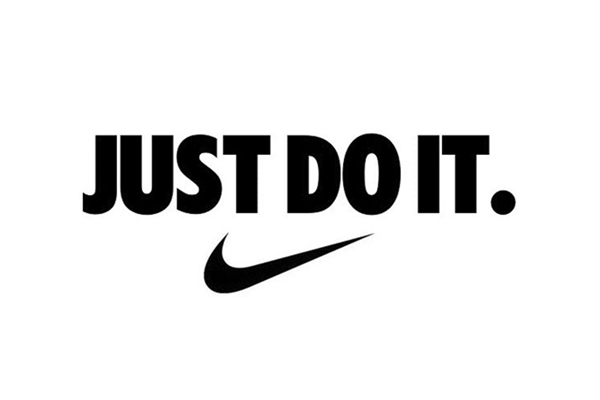
Starbucks
Starbucks has become a household name by focusing on product differentiation, emphasizing the quality of its offerings to attract a clientele of middle to upper-class individuals. The strategic placement of Starbucks stores in bustling urban centers, suburban retail districts, and university campuses enhances accessibility and reinforces its brand image as a place where customers can relax and socialize outside of home and work.
By curating inviting store environments, offering complimentary WiFi, and providing exceptional service alongside a diverse product range, Starbucks creates a distinct customer experience that sets it apart from competitors.
With a massive global presence spanning over 80 countries and a uniform visual identity maintained across its stores worldwide, Starbucks has built a strong brand identity symbolized by the iconic Siren logo. This concerted effort to maintain consistency across locations reinforces the brand’s reputation and ensures a seamless customer experience regardless of geographical location.
Lastly, Starbucks has turned corporate social responsibility (CSR) into a competitive advantage — demonstrating a commitment to environmental sustainability that further enhances its positive brand image and fosters long-term customer loyalty.
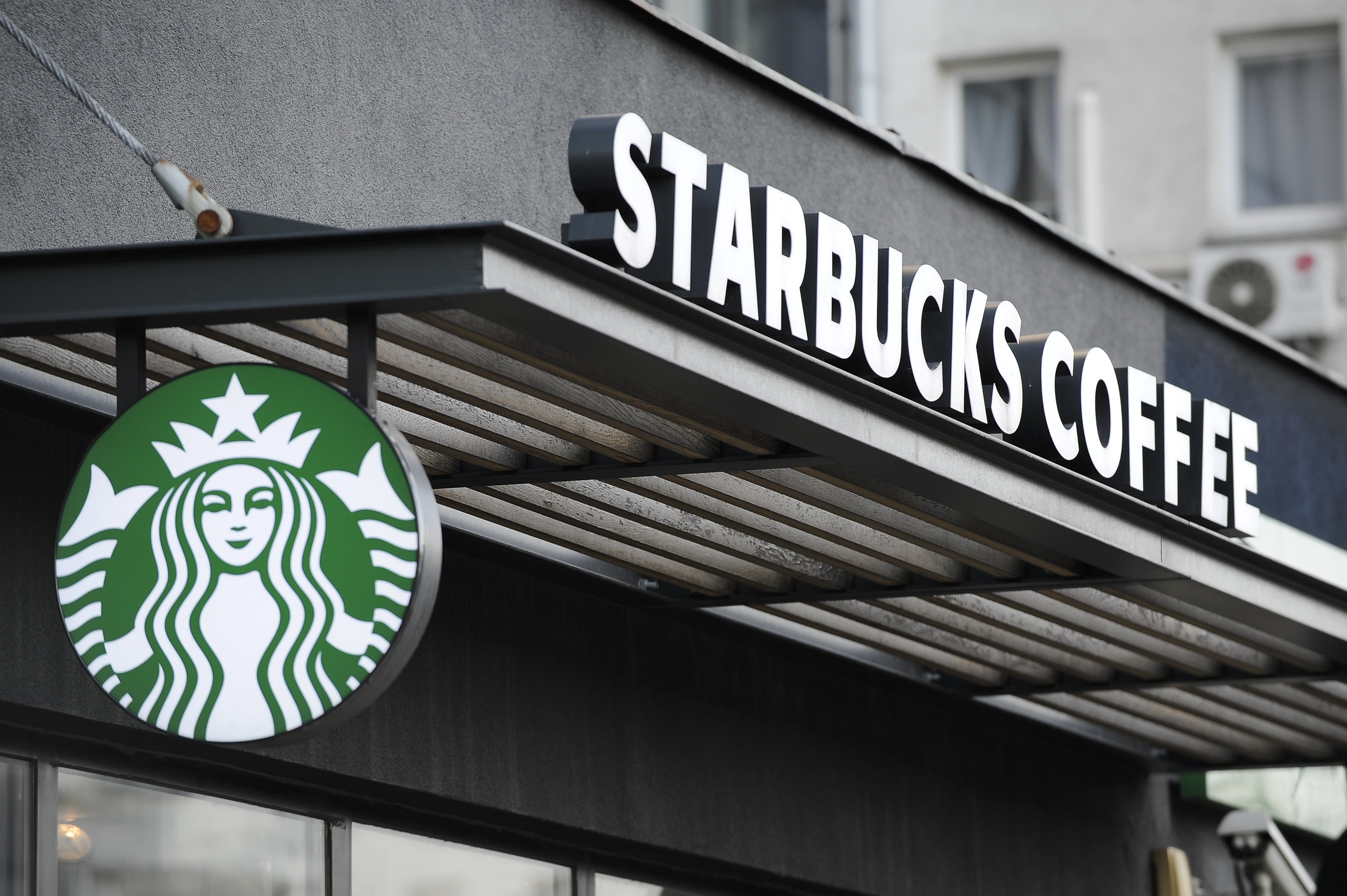
Netflix
Netflix maintains a sustainable competitive advantage through a cost leadership strategy, prioritizing low operational costs and affordable pricing to attract a broad customer base.
With over two decades of experience in the streaming industry, Netflix has developed a robust infrastructure on a large scale, positioning itself ahead of newer competitors entering the market. Rather than focusing on niche segments, Netflix adopts a global approach, aiming to expand its customer reach worldwide and solidify its market presence.
Investment in research and development plays a pivotal role in Netflix’s strategy, driving innovation and addressing customer needs effectively. Through initiatives like the Dynamic Optimizer and the introduction of offline viewing capabilities, Netflix optimizes content delivery and enhances user experience.
Continuous refinement of its recommendation algorithm also enables Netflix to personalize content suggestions according to viewing habits, further enhancing customer engagement and retention.
Unlike its rivals that offer mostly in-house titles, Netflix implements a differentiation strategy by offering original content alongside licensed third-party videos. By working directly with producers and leveraging subscriber data to inform content creation and pricing decisions, Netflix delivers value to its audience while maintaining cost efficiency.
This approach has enabled Netflix to produce compelling content targeted at specific viewer interests, fostering customer loyalty and cementing a sustainable competitive advantage in the streaming industry.
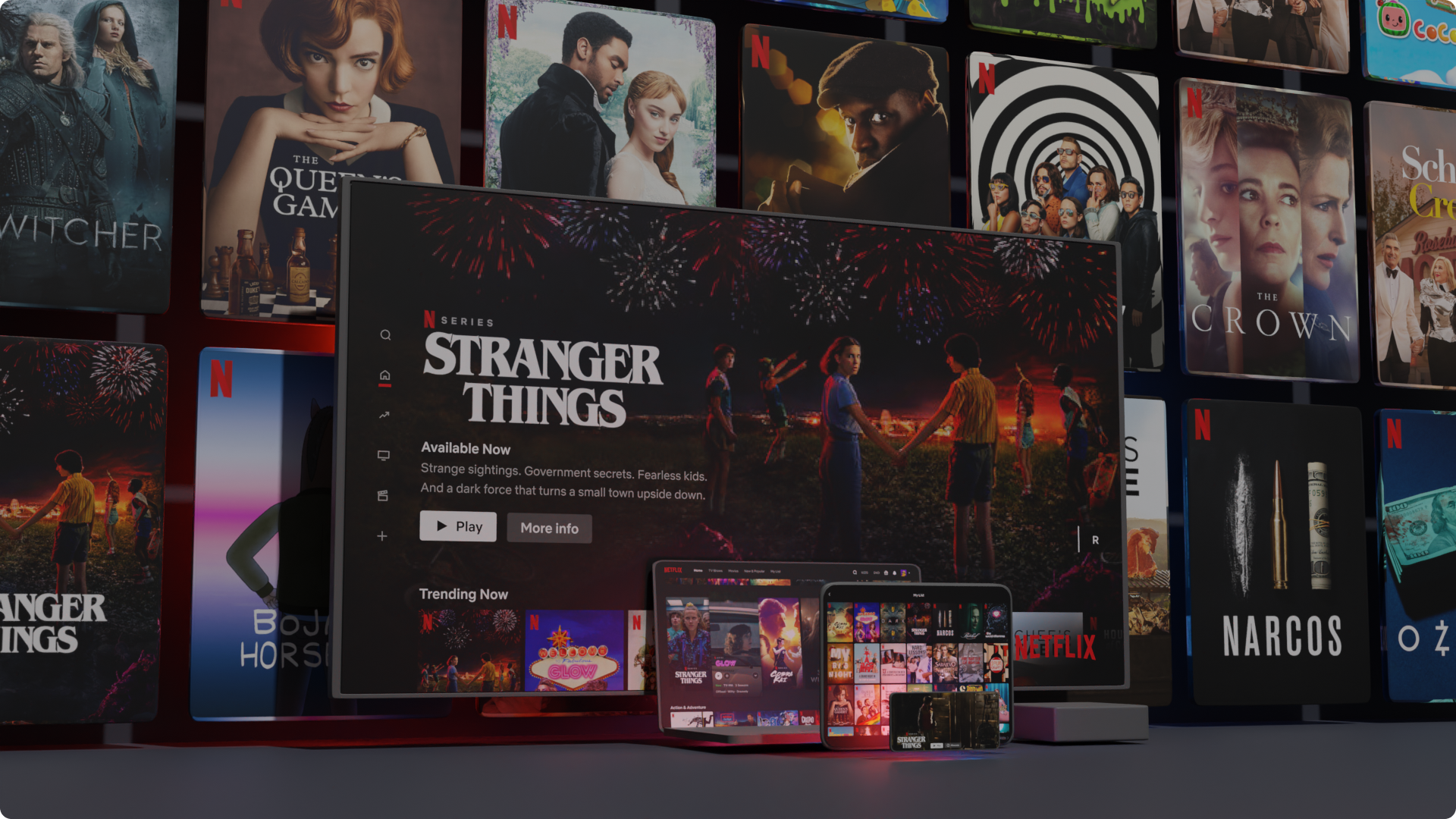
Tesla
Tesla took electric cars from a niche novelty to a must-have status among environmentally conscious consumers.
Rather than targeting all car buyers, Tesla focused on affluent individuals looking for luxury without compromising on eco-friendliness.
Tesla’s biggest competitive advantage is its technological prowess, continuously integrating cutting-edge innovations into its vehicles. With a focus on software-driven functionality, Tesla can collect and analyze data from its vehicles, allowing for continuous improvement and refinement of features such as autopilot.
The use of artificial intelligence further reinforces Tesla’s position at the forefront of autonomous driving technology, with neural networks trained using real-world data captured by Tesla owners.
Like Apple’s approach to product excellence, Tesla has built a reputation for delivering high-quality, stylish automobiles that defy traditional expectations of electric cars. The introduction of the Tesla Roadster shattered stereotypes, showcasing that electric vehicles can be both fast and visually appealing.
Tesla’s vertical integration strategy, particularly in battery production, also provides a significant competitive advantage. The establishment of the Gigafactory drastically reduced battery manufacturing costs through economies of scale, waste reduction, and process optimization.
This strategic move not only enables Tesla to produce more batteries than all other car manufacturers combined but also facilitates continuous improvements in battery quality and chemical composition, further solidifying its dominance in the electric vehicle market.
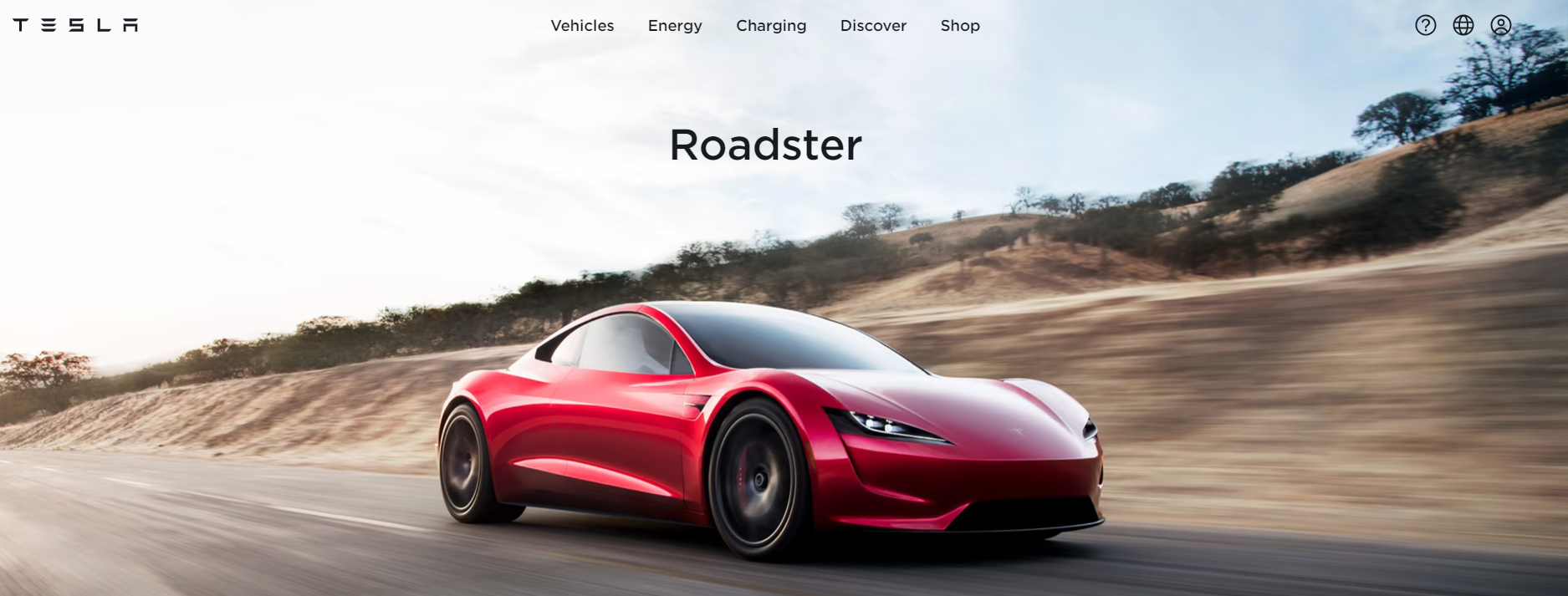
FAQs – Competitive Advantage Examples
What is competitive advantage and an example?
A competitive advantage makes a firm’s goods or services better than its rivals. Apple stands out with its unique ecosystem.
What is an example of a company with a competitive advantage?
Amazon dominates its industry by delivering a vast selection, quick shipping, and stellar customer service.
What is Chick-fil-A’s competitive advantage?
This fast-food giant shines through top-notch customer service and quality eats. Their secret sauce? Treating patrons like gold.
Conclusion
Stepping into the business ring, knowing your secret move matters. That’s where competitive advantage examples shine.
Key takeaways? Cost leadership and differentiation are not just buzzwords; they’re game changers. Innovation keeps you ahead, while globalization opens doors but demands agility.
Sustaining your edge means adapting, evolving, and never settling for yesterday’s win.
To sum up: stay sharp, be unique, and always look forward. The right strategy isn’t just about leading today; it’s about staying ahead tomorrow.

UNLOCK YOUR POTENTIAL
Long Headline that highlights Value Proposition of Lead Magnet
Grab a front row seat to our video masterclasses, interviews, case studies, tutorials, and guides.

